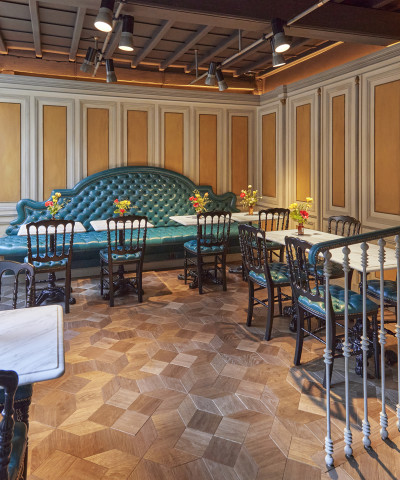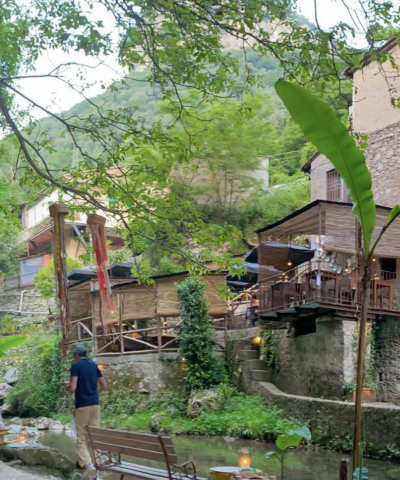The most beautiful panoramic points of Florence
From the hills of Settignano to the heights of Fiesole: a walk to discover an unusual Florence from above
‘In the distant plain lay Florence, pink and gray and brown… all around was a ring of high blue hills, snowed white with countless villas. After nine months of familiarity with this view I still think that this is the fairest picture on our planet’. In 1892 the American writer Mark Twain so described the extraordinary view over the hills which, like a ring, encircle one of the most classic destinations for travellers in search of art and beauty. The belt of hills offers a superb sample of the countryside a stone’s throw from Brunelleschi’s dome, fresh air and breathtaking views of Florence. From the distant fringe of the Careggi hills to the heights of Fiesole and Settignano, via the more famous of the city’s high points, Piazzale Michelangelo and Forte Belvedere, nature and history come together to form the most celebrated and picturesque image of Tuscany: fields and olive groves, vineyards, lines of cypresses and oak forests.
Piazzale Michelangelo
This terrace with the most beautiful views of Florence at sunset divided by the Arno is as famous as Piazza della Signoria. It was designed, at the time when Florence was capital of Italy, by the Florentine architect Giuseppe Poggi. along with the magnificent neoclassical balustrade, which was restored a few years ago. The square is dominated by a bronze copy of Michelangelo’s David. This statue should have replaced the original David, which was moved to the Accademia. But the residents of Florence were not keen on the idea of a bronze David, transported to the square on a cart drawn by nine oxen. From here, a steep climb among the cypresses leads to the wonderful Basilica di San Miniato, Florence’s oldest church. This area, together with the Ramps, will soon be included in the so-called UNESCO area of the historic centre of Florence.
Le Rampe
These are located below Piazzale Michelangelo and are connected to the famous viewpoint by a pedestrian walkway. Le Rampe are also the work of Giuseppe Poggi, completed a few years after the Piazzale. Their purpose was to ensure the stability of the San Miniato hill. But this came hand in hand with beauty: breathtaking panoramic views of Florence, mosaics, grottoes, niches, mascarons and water flowing from the highest point of the Rampe down to the lower levels. This summer the Rampe come back to life with the opening of an exclusive venue, The Lodge (fine dining and cocktail bar) in the restored Chalet delle Rampe, with a fabulous terrace overlooking the city roofs.
Forte Belvedere
Standing on top of the Boboli hill, behind Palazzo Pitti and overlooking the Arno and Ponte Vecchio, this spot offers an exclusive outlook: a 360° view of the city, but above all of the ring of hills that encircle Florence. The fortress was built in the late sixteenth century by Bernardo Buontalenti on the orders of the Medici, who were back in town after a period of exile, and intended as a refuge from potential uprisings and a hiding place for the family’s vast treasure trove. A symbol of Medici power, it has not yet come under attack, and for centuries the Fort’s cannon shots have announced only midday, good-naturedly dubbed by the Florentines “the cannon of pasta”. Today the exterior and interior spaces are home to contemporary art exhibitions in summer, featuring acclaimed international artists.
Fiesole
It’s one of the most delightful hill towns in the Florence area: aristocratic, secluded and studded with beautiful Renaissance villas, cypress-lined avenues and gardens. The best views of Florence are enjoyed from the belvedere at the Convent of San Francesco, which is practically unknown to many, because from Piazza Mino da Fiesole it’s a steep climb up to the Convent. Your efforts are well rewarded. It’s also worth visiting the Roman amphitheatre and the archaeological museum, testimony to Fiesole’s ancient past. Less than a year ago the winery of Bibi Graetz, an extraordinary oenologist, opened in the town square. There’s traditional cuisine at Terrazza 45 (on the square) or at Spaccio della Fattoria di Maiano (on the edge of town). Visitors looking for a gourmet experience should not miss the exclusive Loggia di Villa San Michele.
Settignano
One of the most charming and least visited hills in the Florence area. D’Annunzio moved here, to Villa La Capponcina, in pursuit of Eleonora Duse; Mark Twain, captivated by the views, chose the scenic Villa Viviani. For an awesome view of Florence, the ultimate is the Terrazza di Settignano, below the main cypress-lined square. On weekdays you can visit the beautiful gardens of Villa Gamberaia and perhaps - by appointment only - the lovely Villa I Tatti, once home to the art historian Bernard Berenson, and today headquarters of Harvard University’s Italian Renaissance research centre. A real institution in food and wines is La Sosta del Rossellino with its panoramic veranda, perfect for seekers of the trio food-wine-romance.
Careggi
The hill of Careggi was the favourite place of the most illustrious Florentine citizens back in the fifteenth century; they built their country homes here, attracted by the splendid Villa of Lorenzo the Magnificent, originally home of the Botticelli masterpieces Primavera and The Birth of Venus, today in the Uffizi. From your very first steps into the Viuzzo del Pergolino you’ll leave the hustle and bustle of the city behind as you take in the splendid landscape of olive groves and cultivated fields. Passing a number of beautiful villas with glorious pasts, such as Villa Incontri, Villa Corsini and Villa Le Fontanelle, you can follow country roads among the trees, peeking into the fabulous gardens of the villas.

















